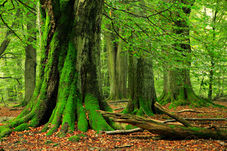Tree Climbing Surveys for Bats
As well as roosting within buildings, bats often use cracks, hollows and holes in trees for shelter; in fact some species are almost exclusively tree-dwelling. Surveying tree roosts can be difficult and ground-based surveys are often inadequate when it comes to definitive information regarding the presence of bats within a tree. Climbing trees to get a closer view of potentially suitable roosting features can be an extremely effective way of determining the presence or absence of bats and can be undertaken at almost any time of the year. This method may avoid the need for costly dusk and dawn emergence surveys and may prevent delays imposed by the timing of such surveys.
Surveying trees for bats is highly specialised work and consultant ecologists at Windrush Ecology Ltd. are experienced both in ground-based and tree-climbing surveys for bats. Tree roosts tend to be much harder to survey and identify than bat roosts in buildings and a number of techniques and specialist equipment can be used including angled mirrors, endoscopes, powerful torches and close-focussing binoculars. Our ecological consultants are licenced by Natural England to survey for bats in all counties of England and are LANTRA trained in tree climbing and aerial rescue to undertake tree climbing surveys for roosting bats. Recent projects have involved the surveying of mature and ancient trees on the Blenheim Palace Estate, the Bedford Estate at Woburn and within the deer park of Hampton Court Palace.
Related content
The Windrush Innovation Centre, Howbery Park, Benson Lane, Crowmarsh Gifford, Wallingford, Oxfordshire OX10 8BA
Hexagon Business Centre, Avenue 4, Station Lane, Witney, Oxfordshire OX28 4BN
Tel: 01491 822681
Tel: 01993 220273
Copyright ©2025 Windrush Ecology Ltd.
Email: enquiry@windrushecology.com






